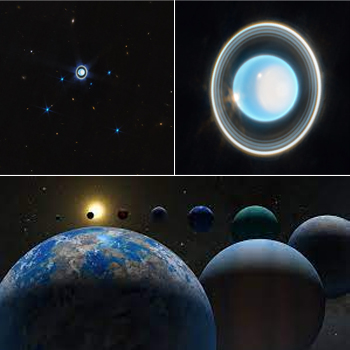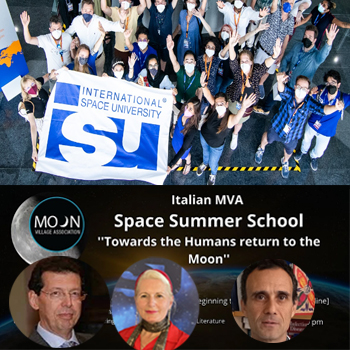Deep Space Exploration and Science Advanced by Upcoming Workshops on Uranus and Exoplanets
Uranus Orbiter and Probe (UOP) mission, the top priority new mission recommended in the 2023-2032 planetary science decadal survey Origins, Worlds, and Life, will be focus of Lunar and Planetary Institute’s Uranus Flagship: Investigations and Instruments for Cross-Discipline Science workshop July 25-27, hosted from Beckman Institute at Caltech in Pasadena CA / online. The 13-ring, 27-moon Uranian system is of great interest and mystery, with a 97.7° axial tilt unique in the Solar System, abnormally low heat flux, and an asymmetric magnetosphere. Furthermore, ‘Uranus’s large ice-rock satellites represent potential ocean worlds that could have astrobiological importance’, and ‘UOP may provide vital ground-truth to exoplanetary science’ as Uranus-sized exoplanets ‘are perhaps the most abundant class of exoplanet’ per the aforementioned decadal survey. Uranus Flagship 2023 will feature panel discussions and oral / poster presentations on Uranus interior, atmosphere and magnetosphere, Uranian moons / rings, mission and instrument concepts, and integration of Diversity, Equity, Inclusion, and Accessibility (DEIA) into UOP. An open discussion on Uranus flagship science moderated by JPL Planetary Scientist Mark Hofstadter and JPL Physicist Jamie Jasinski will conclude the workshop. Also on the California Institute of Technology campus in Pasadena, running nearly concurrently July 24-28, is the 2023 Sagan Exoplanet Summer Hybrid Workshop, Characterizing Exoplanet Atmospheres: The Next Twenty Years at NASA Exoplanet Science Institute (NExScI). EXoplanet CALIbration and Bayesian Unified Retrieval optional half-day session will be held July 29. (Image Credits: JWST, ESA, NASA, CSA-ASC, STScI, JPL, Caltech) |
MONDAY☆ Jul 24 — International Space Station, ~415-km LEO: Expedition 69 seven-member crew working with Ham Radio, Lumina dosimeter, and robotic hand controller experiments; preparing for Cygnus NG-19 S.S. Laurel Clark cargo arrival next week. ☆ Jul 24 — Tiangong Space Station, ~390-km LEO: Shenzhou 16 three-member crew stowing spacesuits and equipment after first EVA for mission; working with 136 space seed crop projects from 53 institutions. Highlights… o NewSpace: Space Pioneer of Beijing raises new funding (US$414M total) for reusable Tianlong-3 rocket set for May 2024 inaugural launch; Rocket Lab recovers Electron booster in step towards reusability; Lunar Vertex multi-spectral microscope (built by Canadensys Aerospace) to undergo further testing / integration after delivery to JHUAPL. ☆ Solar System: Bacterial spores may be capable of withstanding environmental extremes on Europa and Enceladus per research led by astrochemist Edith Fayolle; JUICE now in ‘quiet mode’ until January 2024 instrument checks after passing near-Earth commissioning phase. ☆ Galaxy: Astronomers monitoring PDS 70 system believe it contains pair of exoplanets sharing same orbit, to be confirmed with ALMA NET 2026; Neutron star near Milky Way Galactic Center observed releasing radio burst as asteroid impacts may draw causal link between FRBs and magnetars; Colgate University-led team working to validate dark star theory of extremely high redshift objects using JWST. o Global: CMSA to seek proposals for science payloads to launch on human lunar mission late 2020s; USA and Japan strengthening space ties under ‘Partner to Win’ initiative following USSF-JASDF Space Engagement Talks; Successful 250-second hot firing of Gaganyaan Service Module Propulsion System advances prospects of Q3 2024 uncrewed launch. ● USA: Senate appropriations subcommittee skeptical of Mars Sample Return value, may fund mission US$300M vs $949M requested for FY 2024; NASA preparing for November Artemis human missions architecture concept review; Amazon to build 9,290 m2 / $120M facility at KSC to support planned 3,236-satellites Project Kuiper. ● Hawai’i: ‘Oumuamua debate continues as astrophysicists Sean Raymond, Jason Wright, Steve Desch present arguments for and against natural origin; Keck observation of Janus star being studied for its composition of helium on one side and hydrogen on the other; Mauna Kea Stewardship Oversight Authority now working in 1st month of operations. |
 |
● = Terrestrial and… o = International terrestrial events
☾ = Moon activity ★ = Space and… ☆ = International space / astro events in Hawaii Standard Time unless noted. Add 10 hours to obtain UT (‘Universal Time’). |
Weekly Planet Watch – Evening Planets: Venus (W), Mars (W), Saturn (S); Morning Planets: Jupiter (ENE), Uranus (E), Neptune (SE)
Summer 2023 Education Activities: ISU 35th Space Studies Program and 1st Italy MVA Summer School Feature Exploration and Innovation
International Space University is holding 35th Space Studies Program (the 3rd in the Southern Hemisphere), from June 26 to August 25 in partnership with National Institute for Space Research and Aeronautics Institute of Technology in São José dos Campos, Brazil (~90 km from capital São Paulo). Students will participate in core seminars, workshops, team projects, off-campus activities and professional visits — all of which are structured around 7 academic departments: Human Performance in Space, Space Applications, Engineering, Sciences, Humanities, Management & Business, and Policy, Economics & Law. About 250 international lecturers will provide the students with instruction. This year the team projects will address Smart Cities in the Context of Latin America, Water Security, On-orbit Collision Avoidance Support Service, or The Metaverse Role in the Future of the Space Sector. Now led by President Pascale Ehrenfreund, ISU to date has 5,400 alumni from in 110 countries since its 1987 founding. The First Italian Moon Village Association Space Summer School themed “Towards the Human Return to the Moon” is being organized July 24-25 at La Sapienza University in Rome and online. This multi-disciplinary course will open with Alessandro Bartoloni and MVA President Giuseppe Reibaldi, followed by OASIS 2045 Moon Settlement Panel and a Roundtable with participants from SEDS Italia, SGAC and PoliSpace. Other sessions cover sustainability, lunar radiation, space anthropology, and cislunar construction and activities. (Image Credits: ISU, Moon Village, University of Florence) |
o Jul 24-25 — La Sapienza University in Rome, Hybrid / Rome, Italy and Online: First Italian MVA Space Summer School: ”Towards the Humans return to the Moon”. ● Jul 24-28 — NASA Exoplanet Science Institute (NExScI), Caltech, Hybrid / Pasadena CA and Online: 2023 Sagan Exoplanet Summer Hybrid Workshop Characterizing Exoplanet Atmospheres: The Next Twenty Years. ● Jul 24-28 — Institute for Electric and Electronics Engineers (IEEE), Kansas City MO: 2023 Nuclear and Space Radiation Effects (NETS) Conference. ☆ Jul 24 — Moon: 2.48° NNE of Spica, 21:00. ☆ Jul 24 — Apollo Asteroid 2015 MA54: Near-Earth Flyby (0.042 AU). Continued From… ● Jun 12 – Aug 12 — Institute for Scientist & Engineer Educators at University of California Observatories, University of Hawai’i, Hilo HI: Akamai Internship Program 2023. o Jun 26 – Aug 25 — International Space University (ISU), National Institute for Space Research (INPE), Aeronautics Institute of Technology (ITA), et al, São José dos Campos, Brazil: 35th ISU Space Studies Program (SSP 2023). ● Jul 8-28 — UCSC Other Worlds Laboratory (OWL), Santa Cruz CA: Exoplanet Summer Program (ESP). ☆ Jul 11-28 — Lāhainā Noon: As the Sun passes through the Zenith, directly overhead tropic locations, vertical objects cast no shadows; lā hainā means ‘cruel sun’; Hawai’i Islands dates / times available. ☾ Jul 14 – Aug 23 — Chandrayaan-3, Lunar Landing Trajectory: India Chandrayaan-3 lander and rover to attempt Moon South Pole region landing site near Manzinus U (69.368°S, 32.348°E) ~17:47 IST; second landing window in September. TUESDAY● Jul 25 — NASA, Online / Johnson Space Center, Houston TX: Two Space X Crew-7 mission overview news conferences; 12:30, 14:00 EDT. ● Jul 25-27 — Lunar and Planetary Institute, USRA, Online / Pasadena CA: Uranus Flagship: Investigations and Instruments for Cross-Discipline Science. ☆ Jul 25 — Moon: At first quarter, 12:07. |
WEDNESDAY
● Jul 26 — ISRO, Launch PSLV-C56 / DS-SAR, Satish Dhawan Space Center, India: Commerical launch lofting main payload Singaporean Synthetic Aperture Radar and 6 rideshares, 19:45 IST.
● Jul 26 — Beyond Earth Institute, Online / Washington DC: Webinar: Making Tomorrow’s Moon: Artemis, ILRS, and the Future of Cislunar Development; 13:00-14:30 EDT.
● Jul 26-27 — NOAA Science Advisory Board, Costa Mesa CA: NOAA Science Advisory Board Meeting.
☆ Jul 26 — Mercury: With Venus and Regulus in circle of diameter 5.34°, 22:00.
THURSDAY
● Jul 27 — Northrop Grumman, Online / Falls Church VA: Q2 2023 Northrop Grumman Earnings Conference Call; 09:00 EDT.
o Jul 27 — American University in Cairo (AUC) Astronomy Club, Cairo, Egypt: Future of Moon; including lunar history and future, art drawing competition and prizes.
● Jul 27 — NASA Science Mission Directorate, Online / Washington DC: NASA SMD Virtual Town Hall Meeting; 13:00 EDT.
● Jul 27-28 — NASA Marshall Space Flight Center, National Academies of Sciences, Engineering and Medicine, Huntsville AL: Committee on NASA Mission Critical Workforce, Infrastructure, and Technology – Meeting No. 6.
☆ Jul 27 — Mercury: 5.1° NNE of Venus, 02:00.
☆ Jul 27 — Apollo Asteroid 2018 BG5: Near-Earth Flyby (0.027 AU).
FRIDAY
☆ Jul 28 — Moon: 1.33° NNE of Antares, 09:00.
☆ Jul 28 — Mercury: 0.11° S of Regulus, 15:00.
SATURDAY
☆ Jul 29 — Hubble Space Telescope Visible Pass, ~530-km LEO: Hubble Space Telescope to make visible pass over Hawai’i Islands from SE to E starting 04:10:17 HST, brightest magnitude 2.5.
● Jul 29 — Friends of Thelma Parker Memorial Library, Canada–France–Hawaii Telescope, W. M. Keck Observatory, WHACOS, Girl Scouts, Kahilu Theatre, etc, Kamuela HI: Seeds of Knowledge Community Fair.
● Jul 29 — Hawai’i Board of Land and Natural Resources, Online / Honolulu HI: Tentative Date for TMT Construction Permit Hearing.
☆ Jul 29 — Apollo Asteroid 2020 PP1: Near-Earth Flyby (0.043 AU).
SUNDAY
o Jul 30 – Aug 4 — Asia Oceania Geosciences Society, Singapore: 20th Asia Oceania Geosciences Society (AOGS 2023): Surface Science and Exploration of the Moon and Airless Planetary Bodies.
☆ Jul 30 — Apollo Asteroid 2021 BD3: Near-Earth Flyby (0.035 AU).

